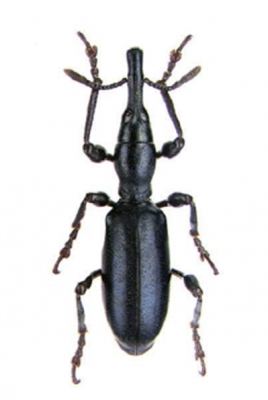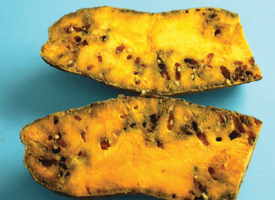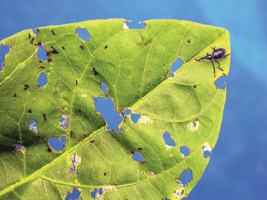Host plants
The only crop attacked by slender sweet potato weevils is sweet potato. They do, however, attack many other plants in the sweet potato family, Convolvulaceae, including morning glory, Ipomoea indica.
Damage
Adult sweet potato weevil characteristically chew small holes into the middle of leaf blades (illustrated) but the resulting damage is insignificant.
Feeding by the larvae boring into storage roots (illustrated) and making deep tunnels is the main cause of yield loss. The flesh of the root turns black in the vicinity of the tunnels and frass is also deposited by the larvae. Toxic terpenes are produced by the roots in response to this, making the roots bitter and inedible, even at low concentrations and at low levels of damage. Infested storage roots are usually spongy in appearance and may show signs of rotting due to secondary infection by pathogens. The larvae also tunnel inside vines, causing malformation, thickening and cracking of the affected areas. When heavy infestations occur, yellowing and stunting of plants may result. Adults, however, prefer to lay their eggs on roots rather than stems; damage symptoms are then only evident once roots are harvested.
Life history
Eggs are laid on stems or storage roots that are either protruding from the ground or are reached via cracks that have formed in the soil. They are deposited singly in small cavities made by the female with her mouthparts. Eggs hatch within a week, and the larvae tunnel into the roots while feeding. When fully grown, they pupate within roots or stems. The life cycle can be as short as one month, but in colder areas this may take longer. Adults live for approximately 2-3 months, and females lay 90-250 eggs. The beetles are sometimes found feeding on leaves during the day. They are, however, seldom seen because they fall to the ground when approached. Adult beetles are readily caught in pheromone traps, indicating that they are capable of directional flight but, as they are nocturnal, they are rarely seen on the wing. During winter, adults can live for up to six months while hiding in places that also provide food, e.g. amongst dumped storage roots.
Natural enemies
The fungus Beauveria bassiana is known to attack slender sweet potato weevils. Other natural enemies include non-selective predators like assassin bugs, spiders and ants.
Management
One pyrethroid insecticide is registered for use in South Africa against weevils that attack sweet potatoes. When larvae start mining the roots, it becomes difficult, if not impossible, to control them with insecticides. It is therefore important to regularly scout fields for the presence of the beetles on leaves.
Pheromones are available to trap Cylas species. One trap per hectare is usually sufficient to monitor the presence or density of these beetles in sweet potato fields. These pheromones are so effective that failure to catch any adults is a reliable indication that the pest is not present.
Because eggs or small larvae of Cylas spp. may be found in stems, care should be taken not to use infested propagation material. In areas where severe infestations have been found the previous season, planting close to these fields again the next season should be avoided. Cylas species have been found to disperse over distances of more than 150 m in a single day.
Larvae and adults may survive in groundkeeper roots left in the soil after harvest and these may serve as a significant source of infestation for the new season. It is therefore also good practice to remove any remaining vines and roots from harvested fields and to be on the lookout for volunteer plants that may emerge in harvested fields. Rotation of fields is also an important practice that will minimize infestations. In areas where these beetles are known to be troublesome, storing roots in the ground is not recommended. Quick-maturing and deep-bearing cultivars are known to suffer less yield loss than long-growers and shallow-bearers.
Rejected roots and vines should never be left on rubbish heaps, because these are known to potentially harbour large populations of beetles. Discarded roots and vines should be destroyed or deeply buried. Scouting of fields for cracked ground during the root-bulking period, especially when shallow-bearing cultivars are planted, is recommended. When these beetles have been troublesome in an area, a special effort should be made to ridge the plants or to fill the cracks with surrounding soil. Regular overhead irrigation is the most effective way of sealing these cracks.
Post-harvest control measures may be needed where roots are stored for curing purpose. Stored roots are vulnerable to egg-laying females of Cylas species that may fly in from outside. Latent infestations not noticed at time of harvest can also be problematic. There are, however, no registered insecticides to protect roots in storage. Using screens around stores and removing infested roots regularly are the only effective measures to prevent heavy losses in storage.
Natural enemies seen not to be effective against sweet potato weevil but the fungus Beauveria bassiana and ants appear to reduce weevil numbers to some extent. Fungal agents, however, are only effective when humidity is high and when weevil numbers are low.







